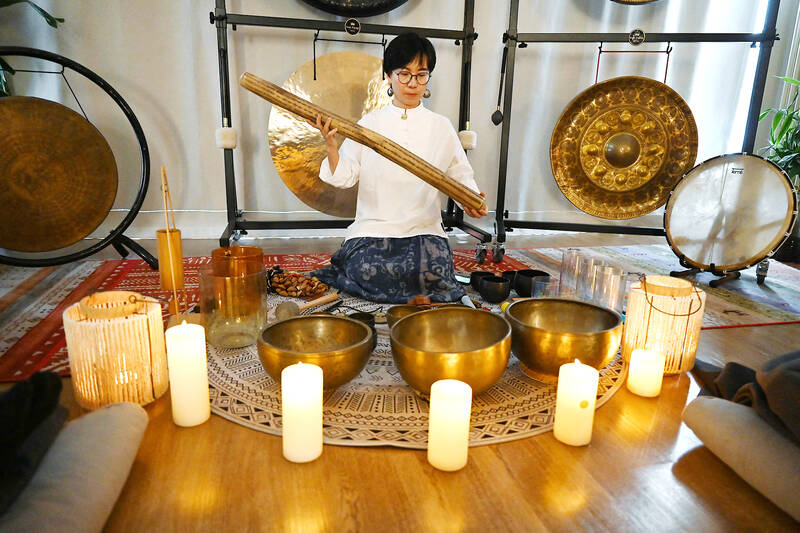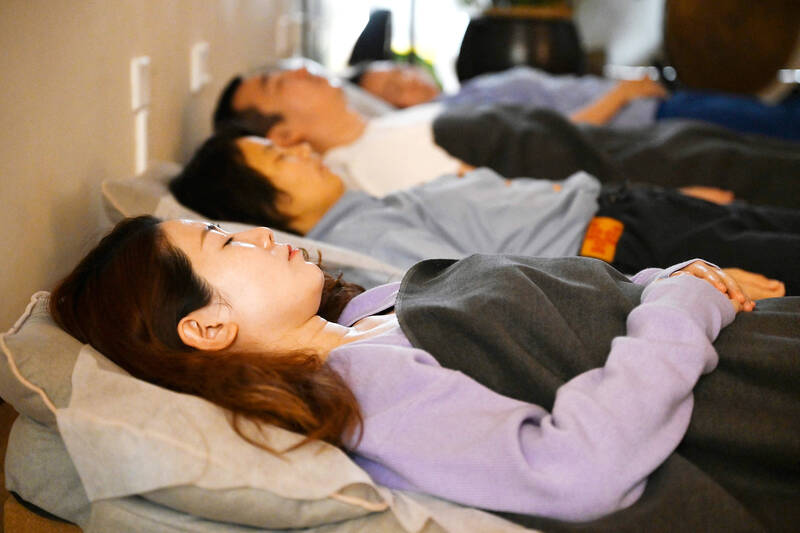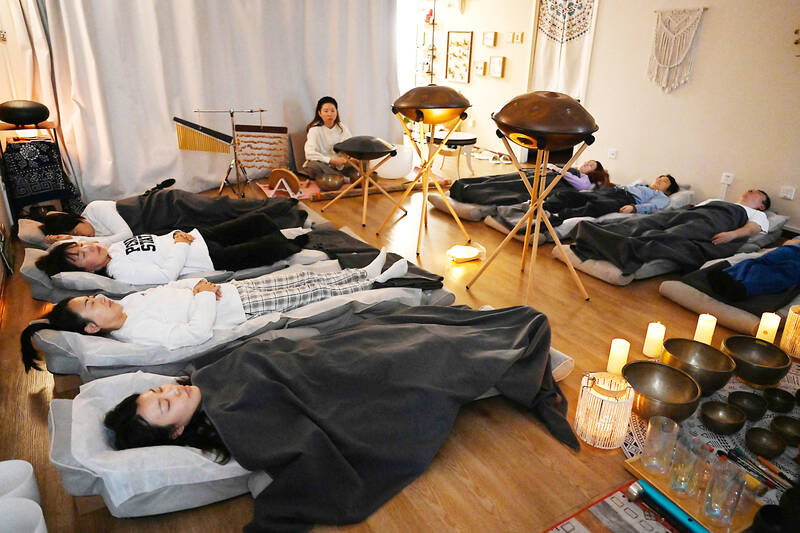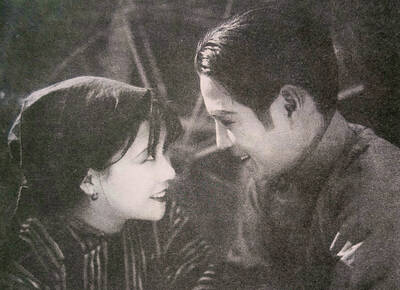It’s just after midday in a quiet studio in Beijing, and Xuan Yi is finally getting the deep sleep she’s craved for months.
Xuan is one of an estimated 300 million Chinese people suffering from insomnia, the product of a high-stress, high-pressure culture that has left many young people choosing to “lie flat” instead.
She tried everything, she says — from psychological counselling to essential oils.

Photo: AFP
“I had a lot of work pressure. I could not go to bed before 2 or 3am and had to get up at 7am to start work,” she says. “I also worked weekends, and my sleep was not very good for a long time.”
But when the curtains close and the singing bowls start humming at healer Li Yan’s studio, she can finally drift off.
To the sounds of a gong, Ukrainian water drum, rainstick and handpans, Xuan and her fellow millennials enter a gentle slumber.

Photo: AFP
Fifty minutes later, they awake after what they say is the best sleep they’ve had in years — at a cost of 180 yuan (US$25).
“Dozens of people with tense minds lay down together and want to give their brains a short break,” Li says.
“It’s like charging your cell phone battery from three percent to 100 percent.”

Photo: AFP
‘LIE FLAT CONCERTS’
“Pressure”, “anxiety” and “insomnia” are the words Li hears most often.
She says she often fields calls from clients desperate for a break.
“I need this therapy right away, in half an hour, I’m so tired,” Li says they tell her.
Many come from China’s competitive IT industry, which has some of the highest incidents of depression and anxiety in the country, according to a National White Paper on Health.
Giants like Alibaba — whose ex-CEO Jack Ma (馬雲) was notorious for demanding that his employees work long hours — have even used Li’s sessions as team-building exercises.
Li calls her work “lie flat concerts,” a reference to a popular meme extolling the virtues of trading the high-pressure life for something a little more easygoing.
But the singing bowls also tie into another growing trend: “short escapes,” in which young people snatch small, zen moments for themselves to escape the daily grind.
HAPPINESS A ‘LUXURY GOOD’
Surrounded by office buildings in the heart of Beijing, Li’s studio offers time slots tailored to the busy routines of young workers.
She says she has seen growing demand in the so-called sleep economy since the COVID-19 pandemic, which the WHO says sparked a 25 percent increase in incidents of depression and anxiety worldwide in its first year.
“Many emotions and problems have come to the surface and people need to deal with their inner selves,” Li says. “Many are actively seeking solutions since the pandemic.”
And in a country where many turn to video games or shopping to unwind, she says, “relaxation and happiness seem to be a luxury good.”
Xuan, for one, is happy to shell out for some decent sleep.
“If I don’t pay for these healing sessions, I might have to pay for the doctor.”

Taiwanese chip-making giant Taiwan Semiconductor Manufacturing Co (TSMC) plans to invest a whopping US$100 billion in the US, after US President Donald Trump threatened to slap tariffs on overseas-made chips. TSMC is the world’s biggest maker of the critical technology that has become the lifeblood of the global economy. This week’s announcement takes the total amount TSMC has pledged to invest in the US to US$165 billion, which the company says is the “largest single foreign direct investment in US history.” It follows Trump’s accusations that Taiwan stole the US chip industry and his threats to impose tariffs of up to 100 percent

On a hillside overlooking Taichung are the remains of a village that never was. Half-formed houses abandoned by investors are slowly succumbing to the elements. Empty, save for the occasional explorer. Taiwan is full of these places. Factories, malls, hospitals, amusement parks, breweries, housing — all facing an unplanned but inevitable obsolescence. Urbex, short for urban exploration, is the practice of exploring and often photographing abandoned and derelict buildings. Many urban explorers choose not to disclose the locations of the sites, as a way of preserving the structures and preventing vandalism or looting. For artist and professor at NTNU and Taipei

March 10 to March 16 Although it failed to become popular, March of the Black Cats (烏貓進行曲) was the first Taiwanese record to have “pop song” printed on the label. Released in March 1929 under Eagle Records, a subsidiary of the Japanese-owned Columbia Records, the Hoklo (commonly known as Taiwanese) lyrics followed the traditional seven characters per verse of Taiwanese opera, but the instrumentation was Western, performed by Eagle’s in-house orchestra. The singer was entertainer Chiu-chan (秋蟾). In fact, a cover of a Xiamen folk song by Chiu-chan released around the same time, Plum Widow Missing Her Husband (雪梅思君), enjoyed more

From insomniacs to party-goers, doting couples, tired paramedics and Johannesburg’s golden youth, The Pantry, a petrol station doubling as a gourmet deli, has become unmissable on the nightlife scene of South Africa’s biggest city. Open 24 hours a day, the establishment which opened three years ago is a haven for revelers looking for a midnight snack to sober up after the bars and nightclubs close at 2am or 5am. “Believe me, we see it all here,” sighs a cashier. Before the curtains open on Johannesburg’s infamous party scene, the evening gets off to a gentle start. On a Friday at around 6pm,